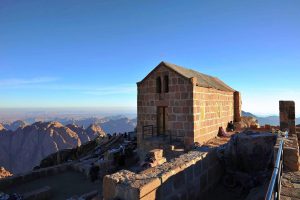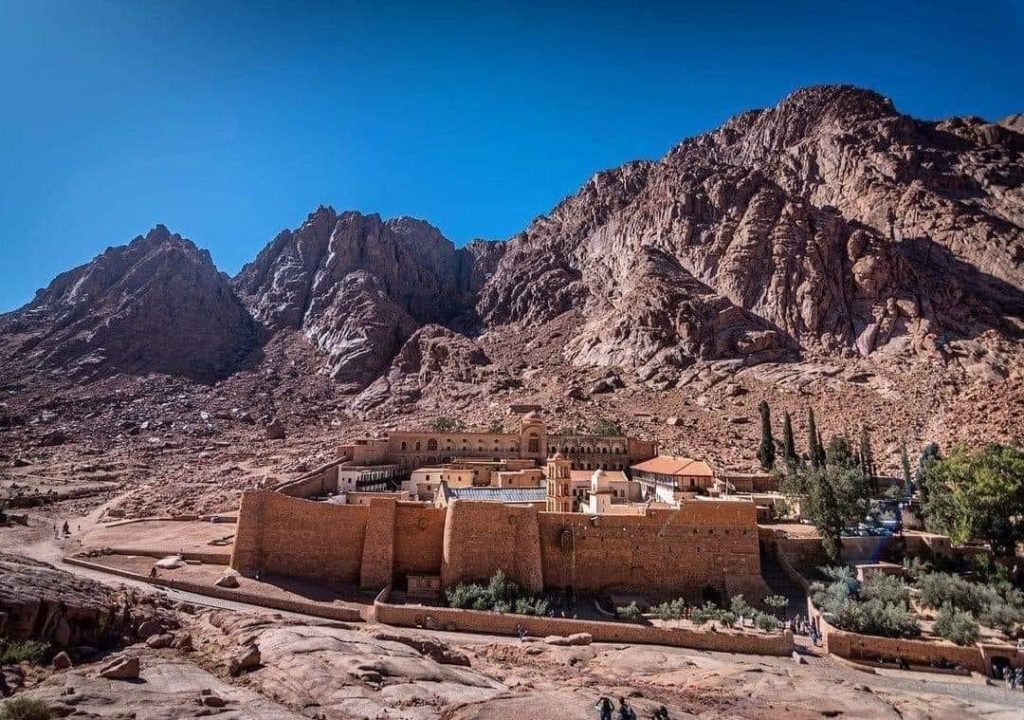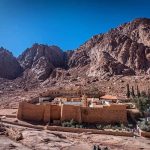Mount Sinai Monastery or Saint Catherine Monastery
The Greek Orthodox monastery of the God-trodden Mount Sinai is located at the very place where God appeared to Moses in the Burning Bush, beneath the Mount of the Decalogue.
In the providence of God, it is at this site also that the holy relics of Saint Catherine are enshrined.

This is the oldest continuously inhabited Christian monastery, with a history that can be traced back over seventeen centuries.
The monastery predates the divisions of the Christian world, its origins extending to late antiquity.
The monastery has never been destroyed in all its history, and thus it can be said to have preserved intact the distinctive qualities of its Greek and Roman heritage.
Members of other Christian confessions have honoured the monastery, coming as pilgrims to this holy place. But from its beginnings, the Christian inhabitants of Sinai belonged to the Greek speaking world, and it has remained so to this day.

The earliest description refers to the Monastery of the Holy Virgin, for the revelation of God at the Burning Bush was seen as a type of the Virgin Mary and the Incarnation.
The monastery is also especially dedicated to the holy prophets Moses and Elias, who both came to this mountain, and who both spoke with Christ at the Transfiguration. More recently, it has been known as Saint Catherine’s Monastery. This remains its name today, though the monastery has not lost its earlier dedications.
Spiritual inheritance
More than one hundred and seventy Sinai saints are honoured by the Church. In addition to Saint Catherine, these include Saint John Climacus, abbot of Sinai and author of The Ladder of Divine Ascent. They also include the ascetic fathers Hesychios and Philotheus, two saints with the name of Anastasius, Gregory of Sinai (who transplanted the Hesychast traditions to the Slavic peoples), and Symeon Pentaglossos (who translated relics of Saint Catherine to Rouen, and thereby helped establish the veneration of Saint Catherine in the West).

The monastery can be thought of as a veritable Ark for its spiritual treasures. These include the manuscripts and early printed books preserved in the Sinai library, which is celebrated throughout the world for the antiquity and importance of its volumes. It also includes the monastery icons, which include the most important collection of pre-iconoclastic panel icons, and icons of the greatest beauty and significance dating from the time of the Comnene dynasty.

The monastery has been honoured by rulers throughout its history. These include the Empress Helena, the Emperor Justinian, Mohammed prophet of Islam, Sultan Selim I, the Empress Catherine of Russia, and Napoleon Bonaparte. Contemporary heads of state have continued to show their interest in the monastery.
The Holy Monastery of Sinai has been celebrated throughout the world for its spiritual and cultural radiance. It has been revered not only by Christians, but also by Moslems and Jews. It has recently been listed by UNESCO as a World Heritage Site, both for its cultural and for its scenic significance.

The monks of Sinai, from earliest times until the present day, maintain a dedication both to prayer and to the support of pilgrims and visitors. They live at peace with the native Bedouin.
They maintain the ancient spiritual heritage of Sinai, a heritage that extends from the giving of the Law, through the whole of the Old and New Testaments, to the multitude of saints whose memory has been enshrined at Sinai – above all, to the All-holy Theotokos, to the holy prophets Moses and Elias, and to Saint Catherine.

A Mosque inside the Monastery
The mosque is located inside the monastery, just to the west of the catholicon. The structure was modified in the 11thcentury. Originally it had served as the monastery refectory (from the 6th century). It is composed of three parts, with access between the three areas by means of large arched openings. In the course of recent renovations, under the plaster there were found crosses carved into the crowns of the arches، The minaret is located opposite the monastery bell tower.

The monastery is located between the two highest mountains of Egypt.
Mount Sinai or Moses Mountain.
It is a 2,285-metre (7,497 ft), moderately high, It is surrounded on all sides by higher peaks in the mountain range of which it is a part.

Mount Catherine at 2,629 m or 8,625 ft, is the highest peak in Egypt.
The story of Saint Catherine
Catherine was born around 287 in Alexandria, Egypt, an important center of culture and learning, as well as faith, in that era. Her father, Cestus, was a man of wealth and importance and his daughter Catherine was well educated in the sciences and the philosophical schools of thought of the ancient world. She was recognized as an intellectual and beautiful woman of the upper class.
At age 14, Catherine had a profound religious vision and decided to become a Christian. In traditional accounts, Christ appeared to her in a dream, giving her a ring, and asking her to be faithful to Him.
Facing the Emperor
However, Catherine lived in troubling times for the followers of Christ. Alexandria was ruled by the Roman Emperor, Maxentius, and legend states that he used his power to cruelly persecute Christians, the religion endorsed by his rival, Constantine. The Emperor forced all his Roman subjects to offer sacrifices to the pagan gods and demonstrate their adherence to the ancient religion and obedience to the Roman state.
Catherine was unable to idly watch so many fearful Christians renouncing their faith. Forsaking her lineage, education, and wealth, she appeared before Maximinus to condemn his idolatry. She admitted that she was a Christian and that she was betrothed to Christ.
In an attempt to outwit and embarrass Catherine, Maxentius called 50 of the most brilliant philosophers to debate with her. Catherine spoke so eloquently that many of the philosophers became convinced and became believers in Christ. All were executed by Maxentius. Infuriated by Catherine’s triumph, the Emperor threw her in the prison and she was condemned to death.
During her imprisonment, hundreds of people came to visit her, including many officials, and even Maxentius’ wife, Valeria Maximilla. Each was converted to Christianity by the saint, and each was
Maxentius is said to have offered Catherine the choice of marriage to him or becoming his mistress. This could have given her power in this political situation but she refused his offer. Maxentius subjected her to all variety of toture but the saint, emboldened by the power of Christ, survived all of this torture unscathed. He ordered that she be executed on the “breaking wheel” but as Catherine was brought out, she touched the wheel, and it shattered. As the events had taken a particularly unfavorable turn for him, Maximinus finally ordered that she be beheaded and on the 25 of November, the date on which the Church venerates her memory, Catherine became a martyr. At the time of her execution, some sources say that there flowed a milky white substance rather than blood. Her martyrdom was in the year 305.

Εpitaphios of Saint Catherine. This epitaphios (cloth icon) is embroidered on salmon-colored brocade fabric, and bears an inscription that refers to the donor who commissioned this piece in Vienna, Azarias the Protosynkellos of Sinai, as well as to other contributors such as priest Georgios, Theodora, and Cyraste, in the year 1805. The central scene includes Moses receiving the Tablets of …. View item.
The Saint of Sinai
The legend continues by saying that the angels then carried Catherine’s body and laid it on Mt. Catherine, near Mt. Sinai. Ancient texts report that the body of the saint was kept for almost three hundred years by ascetics before being discovered in approximately the year 800, during the time of the Byzantine Emperor, Justinian I, and the nearby monastery began to be named for her.
Catherine was selected by the church as one of fourteen “Holy Helpers”, who were thought to be especially powerful intercessors. Pilgrims travel to the remote monastery site to pray for healing. Martyrdom accounts, eulogies, hagiographies, chants, and poems that recount the life and martyrdom of Saint Catherine have been studied by scholars from the eighteenth century to this day. The story of her faith and purity became an especially powerful subject, especially in Renaissance art. And the name, Catherine, remains popular. She is venerated around the world on her feast day, November 25th.



